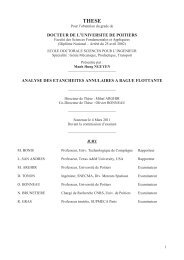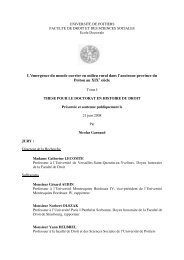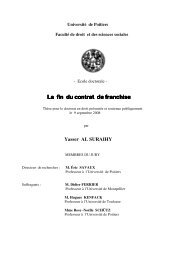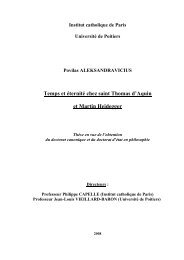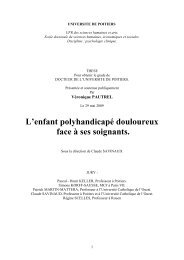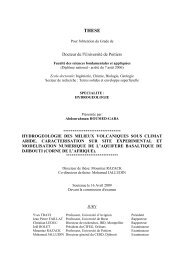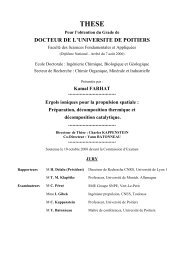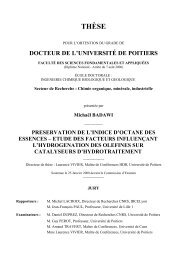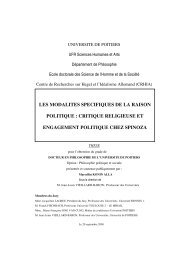Etude et développement d'un actionneur plasma à décharge à ...
Etude et développement d'un actionneur plasma à décharge à ...
Etude et développement d'un actionneur plasma à décharge à ...
You also want an ePaper? Increase the reach of your titles
YUMPU automatically turns print PDFs into web optimized ePapers that Google loves.
ETUDE ET DEVELOPPEMENT D’UN ACTIONNEUR PLASMA A DECHARGE A BARRIERE<br />
DIELECTRIQUE – APPLICATION AU CONTRÔLE D’ECOULEMENT SUR PROFIL D’AILE<br />
La Décharge <strong>à</strong> Barrière Diélectrique (DBD) employée ici consiste en une <strong>décharge</strong> électrique établie dans l’air <strong>à</strong><br />
pression atmosphérique <strong>à</strong> la surface d’un isolant. C<strong>et</strong>te <strong>décharge</strong> ionise l’air ambiant environnant, <strong>et</strong> les espèces chargées<br />
générées soumises <strong>à</strong> la force de Coulomb induisent, par transfert de quantité de mouvement, un écoulement appelé vent<br />
électrique. Récemment, la capacité de ce type de dispositif <strong>à</strong> contrôler un écoulement subsonique autour de profils<br />
aérodynamiques a été mise en évidence. La DBD employée dans ce sens est appelée <strong>actionneur</strong> <strong>plasma</strong>. Ces <strong>actionneur</strong>s<br />
peuvent modifier les écoulements de couche limite en proche paroi par l’intermédiaire du vent électrique. Le but de la thèse<br />
est d’améliorer les performances aérodynamiques d’une aile, soit en augmentant sa portance, soit en réduisant sa traînée ou<br />
bien encore en r<strong>et</strong>ardant le décrochage du profil.<br />
Le travail réalisé se divise en deux grandes parties. La première partie a consisté <strong>à</strong> développer puis optimiser une<br />
<strong>décharge</strong> <strong>à</strong> barrière diélectrique afin de mieux comprendre son fonctionnement. Pour cela, une étude paramétrique a été<br />
effectuée, en faisant varier les grandeurs électriques, physiques <strong>et</strong> géométriques. Des mesures électriques <strong>et</strong> mécaniques ont<br />
été réalisées, puis des grandeurs électromécaniques comme le rendement par exemple ont été estimées <strong>et</strong> comparées. Ces<br />
différentes études ont permis de définir un ensemble de paramètres perm<strong>et</strong>tant d’obtenir une DBD optimum en termes de<br />
génération de vent électrique <strong>et</strong> de fiabilité.<br />
La seconde partie a consisté <strong>à</strong> intégrer l’<strong>actionneur</strong> <strong>plasma</strong> optimisé sur un profil symétrique NACA 0015, <strong>et</strong> de tester<br />
son efficacité dans un écoulement d’air allant jusqu’<strong>à</strong> 40 m/s. Pour cela, des mesures Particle Image Velocim<strong>et</strong>ry (PIV) de<br />
l’écoulement autour du profil <strong>et</strong> des pesées aérodynamiques ont été réalisées sans, puis avec contrôle. L’influence de<br />
différents paramètres (fréquence <strong>et</strong> intensité de l’excitation, mode en fonctionnement) a été étudiée. Il a été mis en évidence<br />
une modification de l’écoulement sous les eff<strong>et</strong>s du contrôle qui favorise soit le processus de recollement de la couche limite<br />
ou soit le décollement. L’efficacité des actions continue <strong>et</strong> instationnaire de l’<strong>actionneur</strong> a été comparée. Modulée par une<br />
fréquence adimensionnelle F +, le mode instationnaire présente des résultats équivalent voire supérieur au mode continu tout<br />
en réduisant la consommation spécifique de la DBD.<br />
STUDY AND DEVELOPMENT OF THE DIELECTRIC BARRIER DISCHARGE (DBD) PLASMA<br />
ACTUATOR – APPLICATION TO AIRFLOW CONTROL ALONG AN AIRFOIL<br />
The Dilectric Barrier Discharge (DBD) employed here consists of a surface electrical discharge established in air at<br />
atmospheric pressure on a dielectric wall. This discharge ionizes the ambient air and the produced species charged submitted<br />
to Coulomb forces induce by a momentum transfer a flow called electric wind. Recently, the ability of this device to control<br />
subsonic airflow around of aerodynamic profils has been demonstrated. The DBD used here is called <strong>plasma</strong> actuator. These<br />
actuators are able to modify the boundary layer close to the wall by the electric wind. The goal of this thesis is to improve the<br />
aerodynamic performances of an airfoil, either by increasing its lift or by reducing its drag, either by delaying the stall of the<br />
profile.<br />
The present work divides in two parts. The first part has consisted in developping and optimizing a dielectric barrier<br />
discharge in order to understand its operating. For that, a param<strong>et</strong>ric study has been conducted by varying the electrical,<br />
physical and geom<strong>et</strong>rical param<strong>et</strong>ers. Electrical and mechanical measurements have been realised. Then the<br />
electromechanical param<strong>et</strong>ers such as efficiency have been d<strong>et</strong>ermined and compared. These different studies allowed to<br />
define a system of param<strong>et</strong>ers allowing to obtain an optimum DBD in terms of electric wind generation and fiability.<br />
The second part has consisted in integrating the optimised <strong>plasma</strong> actuator on a NACA 0015 profile and in testing its<br />
effectiveness to control an airflow up to 40 m/s. For that, Particle Image Velocim<strong>et</strong>ry (PIV) measurements and force balance<br />
measurements have been realized without, and then with control. The influence of different param<strong>et</strong>ers (frequency and<br />
intensity of excitation, operation mode) has been investigated. It was highlighted an airflow modification under the effects of<br />
control which favors the reattachemnt or the d<strong>et</strong>achment. The effectiveness of the steady and unsteady actuations of the<br />
actuator has been compared. Modulated by a dimensionless frequency F +, the unsteady mode presents equivalent results and<br />
even greater than the steady actuation while reducing the consumption of the DBD.



